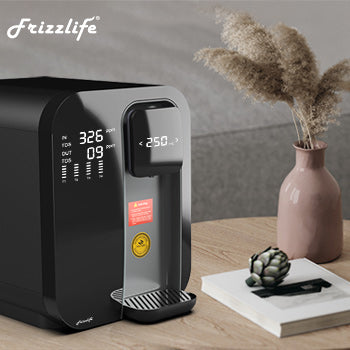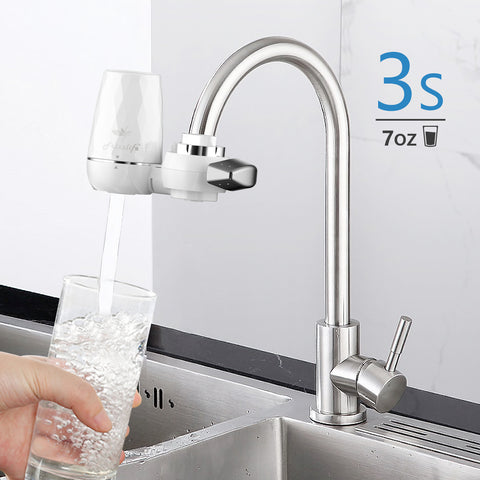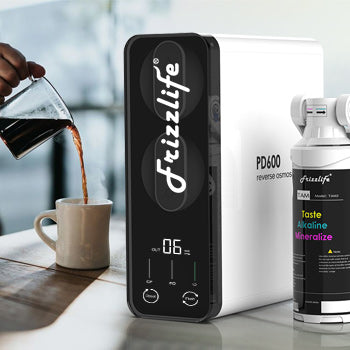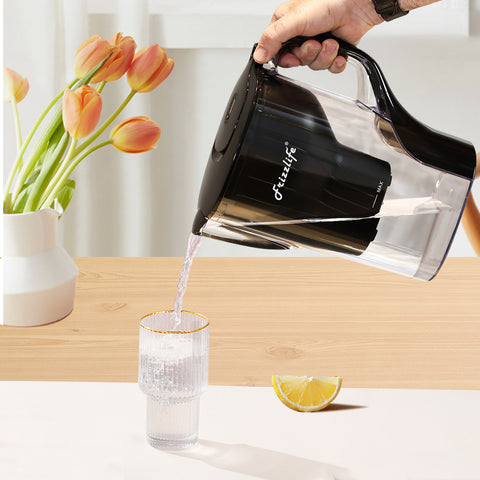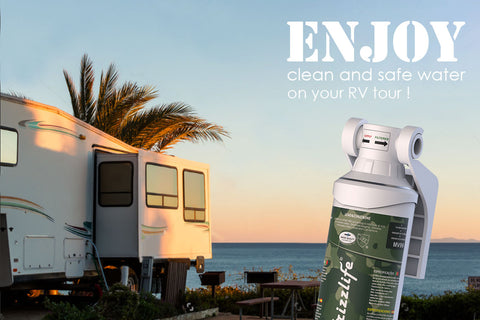|
The Basic Mechanism Of Water Filtration
|
|
As stated by wwdmag.com [2], “filtration is the process in which solid particles in a liquid or gaseous fluid are removed by the use of a filter medium that allows the fluid to pass through while retaining the solid particles.” In the water industry, some of the particles in water are large enough to be visible while some of them are too small to be detected by human eyes. These particles can be captured by different kinds of mediums with different pore sizes. That is also why some of the brands may declare their filters have filtration precision at 5 microns, 0.01 micron, or 1 nanometre as the selling point. The higher the precision, the more particles can be caught by the filters.
Apart from physical filtration, the water treatment systems sometimes also use other specific mediums to absorb typical categories of chemicals and heavy metals in water. The core concept of water treatment is to eliminate all kinds of impurities from water and giving you pure water or better water as the final result.
Different Types of Filtration Mediums:The filter medium serves as the physical barrier between the raw process liquid to the clear filtrate. (iqsdirectory.com[3]) The material to be used as the filter medium must satisfy the following requirements to achieve a successful filtration operation:
There are multiple kinds of filter media. Here we list the most commonly used types:
|
Point of Entry vs. Point of Use
|
|
Now you have a rough idea of different types of filtration materials. Before understanding all kinds of water filtration system, you need to know where the systems will be installed, and decide either to obtain a point of entry (POE) or a point of use (POU) system.
Different from central treatment plats that treat all water distributed to consumers, EPA.Gov[7] stated that the POE & POU treatment devices are designed to treat only a portion of the total flow. POU devices only filter water flow for direct consumption such as for drinking and cooking. It is normally installed at a single tap or limited numbers of taps at a water usage “point”, i.e. kitchen, bathroom. The POE devices are typically installed to treat all water entering a single home, business, school, or facility.
A typical example of POU devices is the under sink water filter or the home reverse osmosis system. A typical example of POE devices is the whole house water filtration system.  Different types of water filtration systems:Understanding all above basic information about the water filters, you may have a rough idea about which system are you going to install and use at each typical “point”. Referring and combined with the article “The 15 Main Water Filter Types, and Their Pros and Cons“ from the waterfilterportal.com,[8] here we list 11 types of different water filtration systems that are most commonly used.
#1 – Countertop water filter Countertop water filters [9] are devices that are filters placed above the sink/on the counter. They normally comes with own faucet/nozzle and can be installed with your existing plumbings or without any installation of plumbing. There are single-stage and multi-stage countertop water filters. A multi-stage basically has more than one filter, which means more contaminants being filtered out, but it also occupies more space. Pros: The prices ranges. They are easy to install or installation-free, quick to filter the water, and filter more than other options like pitcher or faucet water filters. Cons: It will take some of your countertop available space. Frizzlife now has a portable countertop reverse osmosis system[9] which passed WQA water test. It requires no installation. By plugging in the water filter, you can get the pure water whenever you want, in the kitchen, bedroom or even outdoor. Read full reviews about our best selling countertop RO system WA99 from ro-system.org here.[10]
#2 – Faucet Water Filter Faucet filters [11] are small devices that you install in your sink faucet directly, and they have a button to allow the water to pass or not through the filter. You can run it directly without being filtered, or “force” it to pass the faucet filtered to get pure water, which is ideal to drink and cook. Pros: Won’t take any countertop space, unlimited capacity as it comes directly from the faucet, not expensive, small, and easy to install. Cons: The water flow will be slower than when it comes directly from the faucet, and you need to check if your faucet allows the installation of one of these filters.
#3 – Under Sink Water Filter An under sink water filter [12] connects directly to your main water line, is placed under the sink, and usually have their own faucet that should be installed on the countertop near the main faucet. With the emerging needs of water filter without an extra faucet, the direct-connect version of under sink water filter to your main faucet has become popular these years. An under sink water filter can be a reverse osmosis system, an ultrafiltration system, or a general carbon block/granules water filter. Like the countertop water filters, there are single and multi-stage under-sink filters. The multi-stage filters are more powerful because you can combine different filters to remove a great number of contaminants from your water, but the drawback is that these filters take more space. Pros: More aesthetic as the filter will be hidden, stronger filtration, longer lifespans Cons: Takes more space, expensive, more difficult to install.
Find out more about Frizzlife under sink water filter systems. [12]
#4 – Whole House Water Filter Whole House water filters are designed to filter all the water for your home. And for that reason, they will be larger, more potent, and also more expensive than all the other types of filters. They are installed into the mainline of your home to clean the water before it goes to the different zones of your house, and you should use a professional to install one of these water filters. Pros: Powerful filter that removes several contaminants, purifies all the water in your house. Cons: Difficult to install, need to change the filters frequently, and expensive.
#5- Whole House Sediment Pre-filtration System Whole house sediment pre-filtration systems are mostly installed before whole house water filters or other water appliances as a pre-filter to first remove large particles from raw water, before the water goes into the home water supply system. It can largely increase the service life of follow up water appliances and water filters. It is made of anti-burst high-grade molecular materials which can resist massive water pressure. Pros: Reusable and flushable, cheap and durable. Cons: Need to brush the mesh filter per period of time, easy to be clogged.
#6 – Reverse Osmosis System Reverse Osmosis System is a filtration system that uses a semi-permeable membrane to filter out several contaminants, minerals, pesticides, and inorganic components that give you real clean water. Because the membranes are sensitive, these systems typically combine different types of filters, having some pre-filters that remove large particles and chlorine to avoid damaging the membranes and extend the lifespan of the RO system. The RO process[13] is a bit slow, so the system has a pressurized water tank to store the filtered water to be used later. Pros: Filter great amounts of contaminants (up to 99%) and harmful components, one of the most powerful systems to generate clean water, easy to maintain, and have a good lifespan. Cons: They are expensive, generate lots of wastewater (typically in a 3:1 ratio), have a slow filtration process, and take some space.
Frizzlife also launches a product line of tankless reverse osmosis systems[14]. By employing 400-600 GPD RO membrane which has production capacity of 400-600 gal. Of water per day, and a powerful pump, the RO units is able to abandon the bulky and unsanitary water storage tank, serving you instant fresh water whenever you open the dispenser. Find more information.[14] Read full reviews about our best selling RO unit - Frizzlife PD600TAM3 - from ro-system.org.[15]
#7 – Shower Water Filter A shower water filter[16] is a device, like a faucet water filter, that you install directly on your showerhead to filter the water that is used on the shower. There are some versions with their own showerhead also. It is a good option if the water at your home has good amounts of chlorine and fluoride, which can cause dry skin and hair. Pros: Easy to install, not expensive, and improves the health of your hair & skin. Cons: Slows down the flow of your shower, does not remove lots of contaminants.
Find more information about Frizzlife shower buddie and shower water filter system.[16]
#8 – Water Filter Pitcher A Water Filter Pitcher[17] is basically a water pitcher with one water filter built in it to provide simple filtration before you drink the water. Usually, it has an activated carbon filter or a mixed media filter (which has a sediment filter and an activated carbon filter) at the center of the top half, where you pour the water to be filtered, which will then flow to the lower half of the pitcher. It doesn’t have much capacity, so it is typically used for drinking and cooking, but can also be used to get clean water for outdoor activities. Because it is small and portable, you can put it in on the fridge to have cold water when you want to. Pros: Portable, affordable, and easy to use. Cons: It has limited capacity, and may take some time to filter the water.
Find more information about Frizzlife water filter pitcher FP40.[17]
#9 – UV Water Filter A UV filter makes the water pass through a section with a UV lamp, that kills the cells of the microorganisms, removing viruses, bacteria protozoa, etc. This process filters out up to 99.99% of microbiological contaminants from the water. Pros: Great to remove microorganisms from the water, easy to maintain. Cons: Expensive, and do not filter other contaminants, so may need to be combined with other filters.
#10 - Refrigerator Water Filter A refrigerator water filter[18] is designed for the ice maker or the refrigerator. It can be an internal or external water filter. The internal refrigerator water filter is typically designed that can be inserted into the refrigerator filter chamber. Whilst an external refrigerator filter normally uses PEX tubing and copper compression fittings that can be e hooked externally to your appliance. Pros: Independently serve your refrigerator, long service life, cheap. Cons: Sometimes may slow down the water pressure of ice-maker and lead to hollow ice cubes.
Find more information about Frizzlife refrigerator water filter MS99. [18]
#11- RV Water Filter An RV water filter[19] can not only be used for RV, but can also be hooked up to standard garden hoses or garden dispenser, camping water supply, marine or more outdoor usage by using different fittings. Pros: Specially designed for outdoor usage, portable and easy to carry. Cons: Can not filter most kinds of contaminants. It is only recommended to apply for pre-disinfected water.
Find more information about Frizzlife RV water filter MV99.[19] |
|
Conclusion |
|
This article talks about all the common sense about a water filter you may need to know, from its working mechanism, the filtration medium of it and its possible categories. If you have any further comments or any suggestions about the blog, please feel free to contact us at customer@frizzlife.com
Find latest discount of Frizzlife on Wethrift.com
For business cooperation or blog collaboration, please contact us via business@frizzlife.com. |
|
Reference |
|





